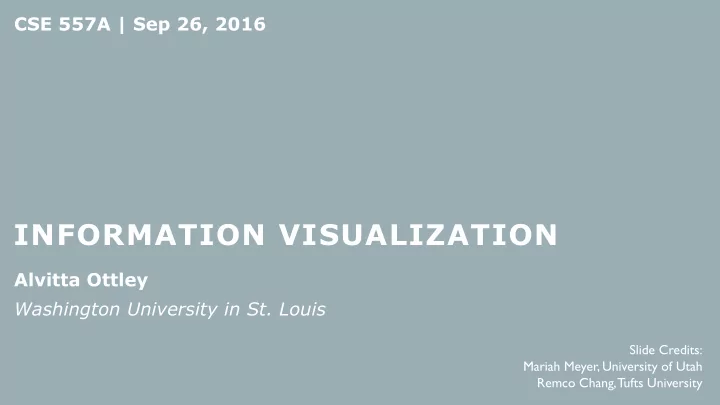

CSE 557A | Sep 26, 2016 INFORMATION VISUALIZATION Alvitta Ottley Washington University in St. Louis Slide Credits: Mariah Meyer, University of Utah Remco Chang, Tufts University
HEIDELBERG LAUREATE FORUM
CSE 557A: INFORMATION VISUALIZATION 1 Assignment 1: Bar and Line Chart Due: 09-28-2016, 11:59pm (midnight) In this assignment, you will be using Processing to draw a bar chart and a line chart. This is your first assignment with Processing and you will be learning the basics of Processing such as, handling mouse events, basic intersection detection, and keeping track of the state of the visualization. You will be required to display a visualization based on input data, and there are a few concepts that you need to explore: (1) reading and parsing data; (2) mouse Due on Wednesday hovering for highlighting visual elements. Basic Requirements: 1. You will be given a simple comma delimited file (CSV) called “data.csv”. This file will have the following properties: a. It has two columns, the first column contains categorical (ordinal) data, and the second column contains quantitative data. b. The first row has labels for each column. c. There are around 10 rows of data. 2. In Processing, do the following: a. Parse the CSV file and read in the data b. The canvas should display the data in the CSV file as a bar chart as default. The bar chart should display each data item as a bar. c. The axes need to be labeled using the labels from the first row of the CSV file. The X- axis should display the categorical data and the Y-axis should display the as “(Apple, 12)”, showing both x be “cut off”.
THE LERP FUNCTION
Recap… Data Types Data Mapping
WHAT IS A DATA VISUALIZATION? • A mapping of data attributes to visual attributes • What are data attributes? • What are visual attributes?
DATA DEFINITION A typical dataset in visualization consists of n records • (r 1 , r 2 , r 3 , … , r n ) • Each record r i consists of m (m >=1) observations or variables • (v 1 , v 2 , v 3 , … , v m ) • A variable may be either independent or dependent • Independent variable (iv) is not controlled or affected by another variable • For example, time in a time-series dataset • Dependent variable (dv) is affected by a variation in one or more associated • independent variables For example, temperature in a region • Formal definition: • r i = (iv 1 , iv 2 , iv 3 , … , iv mi , dv 1 , dv 2 , dv 3 , … , dv md ) • where m = m i + m d •
DATA TYPE TAXONOMY • 1-D • 2-D • 3-D • T emporal • Multi-dimensional • Tree • Network The Eyes Have It, Shneiderman 1996
IS THIS COMPLETE?
BASIC DATA ATTRIBUTES Nominal • Ordinal • Scale / Quantitative • • Interval • Ratio
BASIC DATA ATTRIBUTES (FORMAL) Nominal (N) {…} • Ordinal (O) <…> • Scale / Quantitative (Q) […] • Q → O • • [0, 100] → <F, D, C, B, A> O → N • • <F, D, C, B, A> → {C, B, F, D, A} N → O (??) • • {John, Mike, Bob} → <Bob, John, Mike> • {red, green, blue} → <blue, green, red>?? O → Q (??) • • Hashing? • Bob + John = ?? Readings in Information Visualization: Using Vision To Think. Card, Mackinglay, Schneiderman, 1999
OPERATIONS ON BASIC DATA ATTRIBUTES • What are the operations that we can perform on these data types? Nominal (N) • = and ≠ • Ordinal (O) • >, <, ≥ , ≤ • Scale / Quantitative (Q) • everything else (+, -, *, /, etc.) •
Summary ANY QUESTIONS? Slide courtesy of Mariah Meyer
Today… Visual Attributes Data Mapping
How many times is height encoded?
Multiple encodings: 1. Height of the left line 2. Height of the right line 3. Height of shading 4. Position of top horizontal line 5. Position (placement) of the number 6. Value of the number
ACROSS CHARTS 120 100 80 60 Name Price Apple 12 40 Pear 4 Orange 13 20 Cherry 13 0 Blueberry 8 Banana 2 Peach 13 Lemon 5 Watermelon 15 Lime 24 120 Mango 16 Grape 10 100 Kiwi 1 Pineapple 15 80 Date 110 60 40 20 0
ACROSS CHARTS 120 100 80 60 Name Price Apple 12 40 Pear 4 Orange 13 20 Cherry 13 0 Blueberry 8 Banana 2 Peach 13 Lemon 5 Watermelon 15 Lime 24 120 Mango 16 Grape 10 100 Kiwi 1 Pineapple 15 80 Date 110 Never ever use a line graph for 60 40 categorical data 20 0
IN CLASS EXERCISE…
why is this animation bad?
OTHER WAYS TO REPRESENT 2D DATA Price Price Price Apple 120 Date Pear 100 Pineapple Orange 80 60 Kiwi 40 Cherry 20 0 Grape Blueberry Mango Banana Apple Pear Orange Cherry Blueberry Apple Pear Orange Cherry Blueberry Lime Peach Banana Peach Lemon Watermelon Lime Banana Peach Lemon Watermelon Lime Watermelon Lemon Mango Grape Kiwi Pineapple Date Mango Grape Kiwi Pineapple Date
Types of marks & channels
identify (what and where) magnitude (how much)
identify (what and where) magnitude (how much)
identify (what and where) magnitude (how much)
Expressiveness & effectiveness
expressiveness
magnitude (how much) identify (what or where) expressiveness
Where do the ranking come from?
Bertin, 1967
encoding semantics Ware 2010
NEXT TIME… REQUIRED READING
Recommend
More recommend